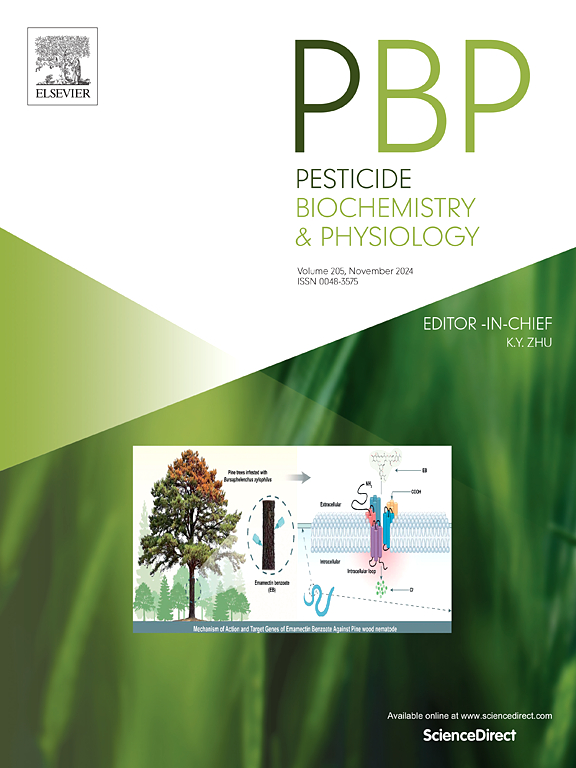Molecular mechanism of Tralopyril-induced enteritis in Pacific oyster (Crassostrea gigas) through multi-pathway modulation: Network toxicology and experimental validation
IF 4
1区 农林科学
Q2 BIOCHEMISTRY & MOLECULAR BIOLOGY
引用次数: 0
Abstract
Tralopyril (TP), a representative bromopyrrolonitrile, functions as a broad-spectrum insecticide, raising growing concerns about its potential impact on aquatic organisms and human intestinal health. However, the key targets and toxicity mechanisms underlying TP-induced enteritis remain unclear. In this study, we utilized network toxicology combined with molecular docking to comprehensively explore the potential molecular mechanisms underlying TP-induced enteritis. A total of 166 TP-related enteritis targets were identified through screening the GeneCards database, and 83 homologous genes were identified in Crassostrea gigas (C. gigas). Using the STRING database and Cytoscape analysis, six core target genes were identified: CDK2, CDK1, EZH2, IAP, CASP3, and ER.Functional enrichment analysis, IBR analysis, and acute exposure experiments demonstrated that TP activates NF-κB and MAPK signaling via the IL-17 pathway, leading to the upregulation of pro-inflammatory factors, which enhances inflammatory responses and suppresses immune function. Moreover, TP activates the ubiquitin–proteasome system and disrupts the expression of cell cycle regulators, thereby disturbing the balance between cell proliferation and apoptosis in intestinal tissues, impairing tissue repair and barrier function. Additionally, TP inhibits AMPK activity, disrupts the SIRT1–NAD+ signaling pathway, and induces oxidative stress.Molecular docking analysis revealed strong binding affinities between TP and multiple core targets, with binding energies below zero. This study elucidates the key molecular mechanisms underlying TP-induced enteritis and provides a theoretical foundation for its environmental and public health risk assessment.

曲洛吡利多途径诱导太平洋牡蛎肠炎的分子机制:网络毒理学和实验验证
Tralopyril (TP)是一种具有代表性的溴吡咯腈,作为一种广谱杀虫剂,其对水生生物和人类肠道健康的潜在影响日益引起人们的关注。然而,tp诱发肠炎的关键靶点和毒性机制尚不清楚。在本研究中,我们利用网络毒理学结合分子对接,全面探索tp诱导肠炎的潜在分子机制。通过筛选GeneCards数据库,共鉴定出166个tp相关肠炎靶点,在长牡蛎(C. gigas)中鉴定出83个同源基因。利用STRING数据库和Cytoscape分析,鉴定出6个核心靶基因:CDK2、CDK1、EZH2、IAP、CASP3和ER。功能富集分析、IBR分析和急性暴露实验表明,TP通过IL-17途径激活NF-κB和MAPK信号,导致促炎因子上调,从而增强炎症反应,抑制免疫功能。此外,TP激活泛素-蛋白酶体系统,扰乱细胞周期调节因子的表达,从而扰乱肠道组织细胞增殖与凋亡的平衡,损害组织修复和屏障功能。此外,TP抑制AMPK活性,破坏SIRT1-NAD +信号通路,诱导氧化应激。分子对接分析显示,TP与多个核心靶点具有较强的结合亲和力,结合能均小于零。本研究阐明了tp致肠炎的关键分子机制,为tp致肠炎的环境和公共卫生风险评价提供了理论依据。
本文章由计算机程序翻译,如有差异,请以英文原文为准。
求助全文
约1分钟内获得全文
求助全文
来源期刊
CiteScore
7.00
自引率
8.50%
发文量
238
审稿时长
4.2 months
期刊介绍:
Pesticide Biochemistry and Physiology publishes original scientific articles pertaining to the mode of action of plant protection agents such as insecticides, fungicides, herbicides, and similar compounds, including nonlethal pest control agents, biosynthesis of pheromones, hormones, and plant resistance agents. Manuscripts may include a biochemical, physiological, or molecular study for an understanding of comparative toxicology or selective toxicity of both target and nontarget organisms. Particular interest will be given to studies on the molecular biology of pest control, toxicology, and pesticide resistance.
Research Areas Emphasized Include the Biochemistry and Physiology of:
• Comparative toxicity
• Mode of action
• Pathophysiology
• Plant growth regulators
• Resistance
• Other effects of pesticides on both parasites and hosts.

 求助内容:
求助内容: 应助结果提醒方式:
应助结果提醒方式:


